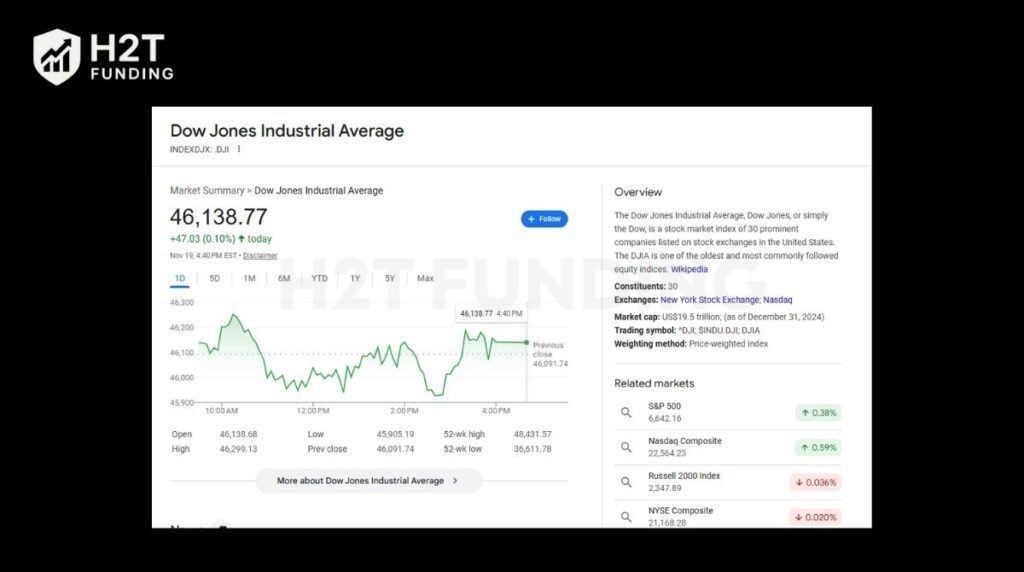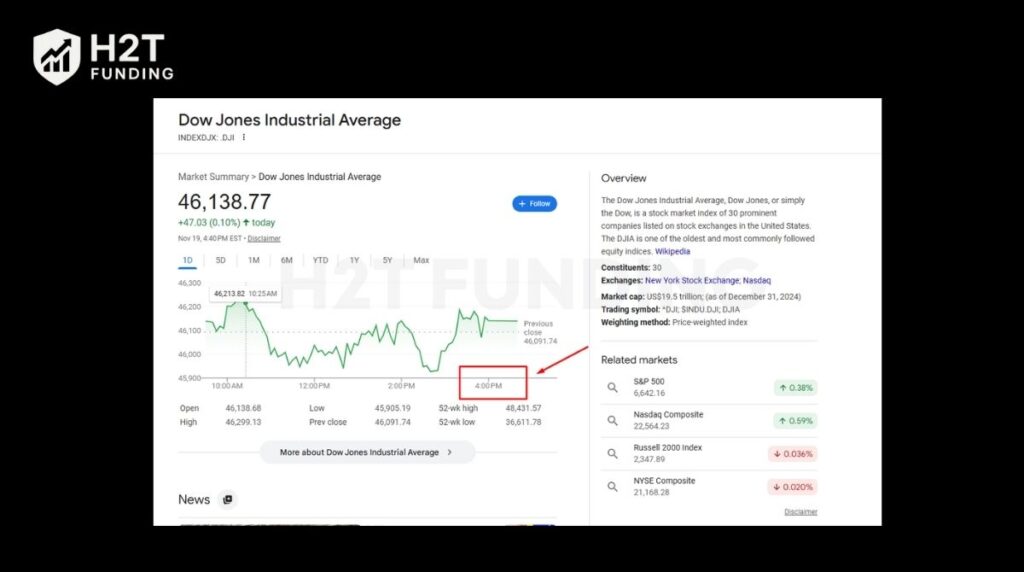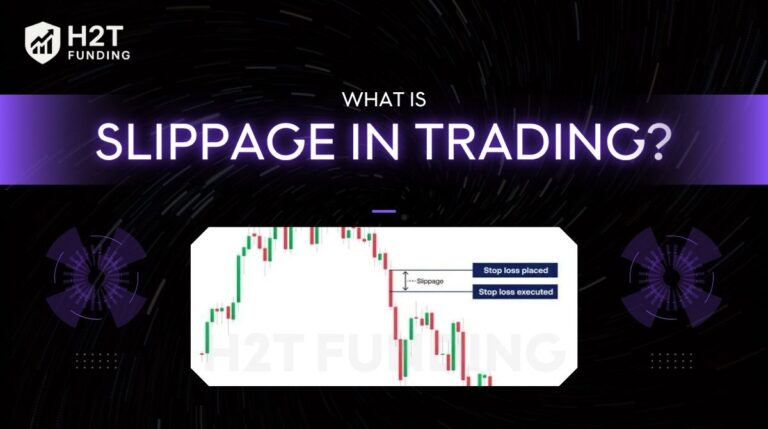If you’ve ever tried to trade U.S. stocks from another time zone, you know how confusing it can get. What time does Dow close today? Does it change during Daylight Saving Time? Honestly, I remember missing trades in my early days just because I didn’t know the market closed earlier on holidays.
So, in this guide, H2T Funding breaks down everything simply, from official trading hours to early closings and after-hours sessions, so you’ll never miss another market move again.
Key takeaways:
- The Dow Jones Industrial Average (DJIA) reflects the performance of 30 major U.S. companies listed on the NYSE and NASDAQ.
- The Dow Jones opens at 9:30 AM and closes at 4:00 PM Eastern Time (ET), Monday through Friday.
- There are three main trading sessions: pre-opening (4:00–9:30 AM ET), core trading (9:30 AM–4:00 PM ET), and after-hours (4:00–8:00 PM ET).
- On market holidays or early-closing days, the market typically closes at 1:00 PM ET.
- Daylight Saving Time shifts can affect international traders, so always check local time conversions.
- The most active periods are right after the open (9:30–10:00 AM) and before the close (3:30–4:00 PM).
- Understanding what time the Dow closes helps traders manage risk and time entries, and react to market news effectively.
- Always verify the official NYSE market calendar to avoid missing trading opportunities.
1. What is the Dow Jones, and why does its closing time matter?
The Dow Jones Industrial Average (DJIA) isn’t a single company; it’s a stock market index that tracks 30 major U.S. companies listed on the NYSE and NASDAQ. Think of it as a snapshot of America’s biggest businesses and their performance.

Because these markets have specific trading hours, knowing exactly when the Dow closes helps you refine your trading plan to time entries and exits more effectively.
Usually, the Dow moves in sync with the core trading session of the NYSE, from 9:30 AM to 4:00 PM Eastern Time (ET). That’s when most trading activity happens, and stock prices are most liquid. Before that, there’s an early trading or pre-opening session where orders queue up, and after 4:00 PM, late trading or after-hours trading continues for those still active.
To put it simply, if you’re watching the Dow, its movement reflects what’s happening across these trading sessions. For traders outside the U.S., especially in the Indian stock market or Asia, converting these hours to your local time is crucial. Missing that 4:00 PM ET closing means you might react too late to big shifts in the economic condition or market news.
Tip: Keep an eye on market holidays and Standard Time vs. Daylight Saving Time shifts. They can change the schedule slightly, especially around July 3rd or Christmas.
2. What time does the Dow close?
The Dow Jones follows the official trading schedule of the New York Stock Exchange (NYSE) and NASDAQ. Both markets open at 9:30 AM and close at 4:00 PM Eastern Time (ET) during regular business hours, Monday through Friday. That’s the standard window when most investors buy and sell securities, and when stock prices move the most.

If we convert that to other time zones:
| Location | Market Opens | Market Closes |
|---|---|---|
| New York (ET) | 9:30 AM | 4:00 PM |
| London (GMT) | 2:30 PM | 9:00 PM |
| India (IST) | 7:00 PM | 1:30 AM (next day) |
| Vietnam (ICT) | 8:30 PM (DST) / 9:30 PM (Standard) | 3:00 AM (DST) / 4:00 AM (Standard) (next day) |
So, if you’re trading from Asia or Europe, your trading day may extend late into the evening. I’ve personally stayed up until 3 AM a few times, watching the Closing Auction to catch the final price swing before the bell. It’s not easy, but sometimes those last few minutes decide your profit or loss.
You might wonder, what about weekends? The U.S. stock exchange is closed on Saturdays and Sundays. However, Dow futures and certain derivatives can still trade in limited sessions. Remember that after-hours trading continues until 8:00 PM ET. Many investors often ask what time the stock market closes after hours, as this session still lets them react to late earnings reports or economic news released in the evening.
Quick note: During Daylight Saving Time, U.S. trading hours shift one hour earlier for traders in countries that do not change clocks. Always double-check your local conversion before placing trades, especially around March and November.
3. U.S. stock market trading hours overview
To understand what time does dow jones close, we first need to look at how trading sessions work across the U.S. markets, which have a fixed schedule, unlike how forex currency trading works. The NYSE and NASDAQ share the same trading hours, with three main sessions: pre-opening, core trading, and after-hours.
- Pre-opening session (early trading): Technically runs from 4:00 AM to 9:30 AM Eastern Time (ET), though availability depends on your broker, with many starting closer to 7:00 AM. During this time, orders queue up to help institutions prepare before the Opening Auction.
- Core trading session: This is the most active period, from 9:30 AM to 4:00 PM ET. Most securities, including equity options and ETF options, are traded here. Market liquidity and volatility peak during this session.
- After-hours trading (late trading): Extends from 4:00 PM to 8:00 PM ET. Although volume is lower, it’s when news, earnings, or economic condition data can move stock prices.
The table below sums it up:
| Session | Time (Eastern Time) | Notes |
|---|---|---|
| Pre-opening (early trading) | 4:00 AM – 9:30 AM | Orders placed but not executed |
| Core trading | 9:30 AM – 4:00 PM | Main session, high liquidity |
| After-hours (late trading) | 4:00 PM – 8:00 PM | Reaction to news and reports |
So, when someone asks what time the Dow Jones closes today, it always aligns with the NYSE’s main closing at 4:00 PM ET, unless there’s an early close due to market holidays. This schedule applies across most auction-eligible symbols, including major indexes, index options, and ETN options.
4. Market holidays and early closing days
If you’ve ever checked the markets on a holiday and found them closed, you’re not alone. Many traders ask what time does stock market closes today or whether the stock market closes early before national holidays. The truth is, the NYSE and NASDAQ both follow a clear annual calendar for market holidays and early-closing days.

Here are the main U.S. market holidays when the Dow Jones and other stock exchange activity stop completely:
| Holiday | Date | Status |
|---|---|---|
| New Year’s Day | January 1 | Closed |
| Martin Luther King Jr. Day | Third Monday of January | Closed |
| Presidents’ Day | Third Monday of February | Closed |
| Good Friday | Varies (March or April) | Closed |
| Memorial Day | Last Monday of May | Closed |
| Juneteenth National Independence Day | June 19 | Closed |
| Independence Day | July 4 | Closed or early close (July 3 at 1 PM ET) |
| Labor Day | First Monday of September | Closed |
| Thanksgiving Day | Fourth Thursday of November | Closed or early close (Friday 1 PM ET) |
| Christmas Day | December 25 | Closed or early close (Christmas Eve 1 PM ET) |
Early closings typically occur at 1:00 PM ET on specific days, such as July 3rd, Black Friday (after Thanksgiving), and Christmas Eve. On these days, the core trading window is shortened, meaning the Dow Jones effectively closes earlier than the usual 4:00 PM ET.
So, if you’re wondering what time the Dow Jones market closes, remember that exceptions happen only during holidays. Always double-check the NYSE market calendar to avoid confusion, especially if you trade from overseas.
5. How trading hours affect Dow Jones movements
Understanding the timing of each trading session can help explain why the Dow Jones behaves differently throughout the day. When people ask what time the Dow closes, they often want to know when volatility peaks or slows down.
In my experience, the first and last 30 minutes of the trading day are the most volatile. Therefore, avoiding this chaos is often the best trading strategy for beginners.
This is when large institutions rebalance portfolios, triggering strong price moves. The 10 AM rule suggests that early morning volatility usually settles by that time. Once the market stabilizes, you can apply methods on how to trade using indicators more effectively.
During early trading or the pre-opening session, liquidity is lower, and spreads can be wide. But by the core trading period, volume surges as both U.S. and international investors join in. Later, during after-hours trading, moves can be unpredictable since fewer participants mean sharper reactions to news or earnings.
You can think of it like this:
| Time (ET) | Typical activity | Notes |
|---|---|---|
| 9:30–10:00 AM | High volatility | The market reacts to overnight data |
| 10:00 AM–3:30 PM | Moderate trend trading | Liquidity stabilizes |
| 3:30–4:00 PM | Sharp moves | Closing positions, rebalancing |
| After 4:00 PM | Limited activity | After-hours trading with low volume |
So, what time does Dow close today matters more than just the clock; it defines when liquidity dries up and volatility spikes. If you plan to trade around the closing auction, keep in mind that even small orders can move stock prices significantly right before the bell.
6. Dow Jones futures vs. stock market closing time
Here’s the simple truth: while the regular stock market locks its doors strictly at 4:00 PM ET, Dow Jones futures keep trading nearly 24 hours a day.
Think of the cash market (DJIA) as a standard 9-to-5 job, whereas futures are the “night shift” that reacts to global events while New York sleeps. Honestly, realizing this distinction was a lightbulb moment for me; it explains why stocks often “gap” up or down right at the opening bell.
To break it down:
- Stock Market (DJIA): Trades only during core hours, 9:30 AM – 4:00 PM ET, Monday to Friday.
- Dow Futures (E-mini YM): Run from Sunday 6:00 PM ET straight through to Friday 5:00 PM ET.
- The Nap Time: Even futures need a break. There is a daily maintenance halt from 5:00 PM to 6:00 PM ET, where trading stops completely.
So, why does this matter? If you see futures tanking at 3:00 AM due to news in Europe, don’t expect the Dow to open flat at 9:30 AM. Futures effectively give you a sneak peek into how the market will open the next day.
7. How to trade around the Dow Jones closing time
Trading the final minutes of the session is all about managing the massive volatility spike known as “Power Hour.” Honestly, the period from 3:00 PM to 4:00 PM ET is a double-edged sword: it offers the highest liquidity of the day, but it’s also where price swings can get irrational.
This happens because big institutions (like mutual funds) rush to rebalance their books right before the bell. If you want to trade this window without getting wrecked, here is how I approach it:
- Watch out for 3:50 PM ET: This is when the NYSE publishes “Market On Close” imbalances. Prices often jerk violently in one direction based on these orders, so don’t be caught off guard.
- Avoid Market Orders: Trust me on this; never use a market order in the last 5 minutes. The spread can widen unexpectedly, and you might get filled at a terrible price (we call this slippage). Always use limit orders to control your entry.
- Flatten out early: Unless you plan to hold overnight, I recommend closing your day trades by 3:55 PM. Don’t get greedy trying to catch the final tick; getting stuck in the closing auction means facing “gap risk” the next morning, which simply isn’t worth the stress.
Simply put, the closing bell isn’t the time to gamble. I’ve seen too many traders give back their entire day’s profit in those final chaotic minutes just because they lacked discipline. If you aren’t 100% confident, just sit on your hands sometimes; the best trade is the one you don’t take.
8. FAQs – Common questions about Dow Jones trading hours
If you need to know exactly what time does dow jones close today, the answer is usually 4:00 PM Eastern Time (ET), following the NYSE schedule. On holidays or early-close days, it may shut at 1:00 PM ET.
It opens at 9:30 AM ET and closes at 4:00 PM ET during regular business hours, Monday through Friday.
Only if it’s a designated early-close day such as July 3rd, Thanksgiving Friday, or Christmas Eve.
Yes, trades continue until the Closing Auction at 4:00 PM ET, and then through after-hours trading until 8:00 PM ET.
It’s an informal rule suggesting the first 30 minutes of trading are highly volatile, and clearer market trends often appear after 10 AM.
No, U.S. stock exchanges close on Saturdays and Sundays, though Dow futures may trade in limited sessions.
Still at 4:00 PM ET, but for traders in other countries, the local time may shift one hour earlier.
Once the Dow Jones closes, trading moves to the after-hours session, where earnings releases and economic condition updates can still impact stock prices.
Yes, both follow the same trading schedule, so movements in one can influence the other throughout the day.
Simply searching for what time Dow closes is not enough; precise timing matters because it affects execution speed, spreads, and liquidity. Missing the closing session can mean losing key opportunities or reacting late to major market moves.
The Singapore Exchange (SGX) wraps up its trading day at 5:00 PM Singapore Time (SGT). Since there is a significant time difference, the Singapore market is already closed long before the U.S. trading session even begins.
It depends on which “stock market” you are referring to. If you are trading U.S. markets (like the Dow, NYSE, or NASDAQ), the answer is strictly 4:00 PM ET. However, people often get confused because the London Stock Exchange (LSE) closes at 4:30 PM local time. So, always check the specific country to be sure.
9. Conclusion
To wrap up, knowing what time does the Dow open and close is more than just a matter of routine; it’s part of trading smart. The Dow Jones opens at 9:30 AM and closes at 4:00 PM Eastern Time (ET), aligning with both the NYSE and NASDAQ trading hours. These times define the most liquid and volatile moments of the trading day.
For international traders, especially those in Asia or Europe, converting these hours correctly helps avoid missed opportunities or late reactions to market swings. Keep an eye on market holidays and early closings, since they can shift your trading window by a few hours.
At H2T Funding, we believe every successful trader should understand timing as deeply as strategy. Whether you’re exploring the Prop Firm & Trading Strategies category or getting ready for your next trade, make sure you know when markets open and close. It helps you plan better, manage risk effectively, and seize opportunities before the closing bell.





